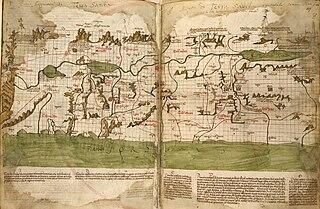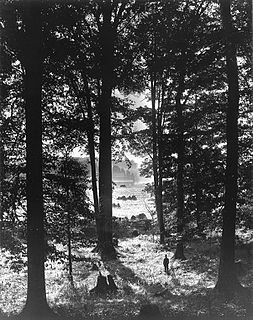Sacred grove or similar may mean:

A temple is a building reserved for religious or spiritual rituals and activities such as prayer and sacrifice. The term typically used for such buildings belonging to all faiths where a more specific term such as church, mosque or synagogue is not generally used in English. These include Hinduism, Buddhism, Sikhism and Jainism among religions with many modern followers, as well as other ancient religions such as Ancient Egyptian religion.

The Holy Land is an area roughly located between the Mediterranean Sea and the Eastern Bank of the Jordan River. Traditionally, it is synonymous both with the biblical Land of Israel and with the region of Palestine. The term "Holy Land" usually refers to a territory roughly corresponding to the modern State of Israel, the Palestinian territories, western Jordan, and parts of southern Lebanon and southwestern Syria. Jews, Christians, and Muslims regard it as holy.

Adam-ondi-Ahman is a historic site in Daviess County, Missouri, about five miles south of Jameson. It is located along the east bluffs above the Grand River. According to the teachings of The Church of Jesus Christ of Latter-day Saints, it is the site where Adam and Eve lived after being expelled from the Garden of Eden. It teaches that the place will be a gathering spot for a meeting of the priesthood leadership, including prophets of all ages and other righteous people, prior to the Second Coming of Jesus Christ.

Laie Hawaii Temple is a temple of The Church of Jesus Christ of Latter-day Saints located on the northeast shore of the Hawaiian island of Oʻahu. The temple sits on a small hill, a half-mile from the Pacific Ocean, in the town of Lāʻie, 35 miles (56 km) from Honolulu. Along with Brigham Young University–Hawaii and the Polynesian Cultural Center, the Laie Hawaii Temple plays an important role in the town of Lā'ie, with the Visitors' Center attracting more than 100,000 people annually.

Shorea robusta, the sal tree, also sarai and other names, is a species of tree in the family Dipterocarpaceae.

The Conference Center, in Salt Lake City, Utah, is the premier meeting hall for The Church of Jesus Christ of Latter-day Saints. Completed in 2000, the 21,000-seat Conference Center replaced the traditional use of the nearby Salt Lake Tabernacle, built in 1868, for biannual LDS Church General Conference and major church gatherings, devotionals, and other events. It is believed to be the largest theater-style auditorium ever built.

A sacred grove or sacred woods are any grove of trees that are of special religious importance to a particular culture. Sacred groves feature in various cultures throughout the world. They were important features of the mythological landscape and cult practice of Celtic, Estonian, Baltic, Germanic, ancient Greek, Near Eastern, Roman, and Slavic polytheism, and continue to occur in locations such as India, Japan, and West Africa. Examples of sacred groves include the Greco-Roman temenos, various Germanic words for sacred groves, and the Celtic nemeton, which was largely but not exclusively associated with Druidic practice. During the Northern Crusades, there was a common practice of building churches on the sites of sacred groves. The Lakota and various other North American tribes consider particular forests or other natural landmarks to be sacred. Singular trees which a community deems to hold religious significance are known as sacred trees.

Far West was a settlement of Latter Day Saint movement in Caldwell County, Missouri, United States, during the late 1830s. It is recognized as a historic site by the U.S. National Register of Historic Places, added to the register in 1970. It is owned and maintained by The Church of Jesus Christ of Latter-day Saints.

The Temple in Independence, Missouri, is a house of worship and education "dedicated to the pursuit of peace". It dominates the skyline of Independence and has become the focal point of the headquarters of the Community of Christ. The temple was built by the Community of Christ in response to a revelation presented at their 1984 World Conference by church prophet-president Wallace B. Smith. The revelation was the culmination of instructions shared over the course of more than 150 years by prior prophet-presidents recognized by the Community of Christ. Groundbreaking for the temple took place on April 6, 1990, and the completed structure was dedicated on April 17, 1994.

The Oakland California Temple is the 15th constructed and 13th operating temple of The Church of Jesus Christ of Latter-day Saints. During a January 23, 1961 meeting, plans for the temple were announced by David O. McKay. Ground was broken on May 26, 1962, with the cornerstone laid May 25, 1963, and dedication on November 19, 1964.

The Palmyra New York Temple is the 77th operating temple of The Church of Jesus Christ of Latter-day Saints.

In The Church of Jesus Christ of Latter-day Saints, the Holy of Holies or Holiest of Holies is a room in the Salt Lake Temple wherein the church's president—acting as the Presiding High Priest of the church—enters to act as High Priest of Israel in direct relationship with God, in accordance with the LDS interpretation of the Book of Exodus. Hence, this Holy of Holies in the temple is considered by adherents to be a modern cognate to the inner sanctuary of the Tabernacle and Temple in Jerusalem. The room was also the place where the second anointing ordinance was administered, although now any room in a temple set apart for this purpose is used.

The Sacred Grove is a forested area of western New York near the home of Joseph Smith where the foundational event of the Latter Day Saint movement took place. It is the location where Smith said he had his First Vision, a theophany, occurring in the spring of 1820.

The Temple Lot, located in Independence, Jackson County, Missouri, is the first site to be dedicated for the construction of a temple in the Latter Day Saint movement. The area was dedicated on August 3, 1831, by the movement's founder, Joseph Smith Jr., and purchased on December 19, 1831, by his colleague Edward Partridge to be the center of the New Jerusalem or "City of Zion" after he received a revelation stating that it would be the gathering spot of the Latter Day Saints during the last days.

The Rome Italy Temple is a temple of The Church of Jesus Christ of Latter-day Saints in Rome, Italy. The temple serves church members in Italy, as well as Malta, Greece, Cyprus, Albania and parts of Romania. Thomas S. Monson, the LDS Church's president, initially announced the temple in 2008, a groundbreaking took place in 2010, and the temple opened after its dedication in 2019.

The Church of Jesus Christ of Latter-day Saints in New York refers to The Church of Jesus Christ of Latter-day Saints and its members in New York.

The Smith Family Farm was the boyhood home of Joseph Smith, the founder of the Latter Day Saint movement.

The following outline is provided as an overview of and topical guide to the life and influence of Joseph Smith:

Trees hold a particular role in Germanic paganism and Germanic mythology, both as individuals and in groups. The central role of trees in Germanic religion is noted in the earliest written reports about the Germanic peoples, with the Roman historian Tacitus stating that Germanic cult practices took place exclusively in groves rather than temples. Scholars consider that reverence for and rites performed at individual trees are derived from the mythological role of the world tree, Yggdrasil; onomastic and some historical evidence also connects individual deities to both groves and individual trees. After Christianization, trees continue to play a significant role in the folk beliefs of the Germanic peoples.